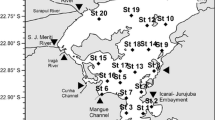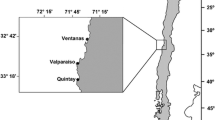Abstract
Effects of metal contamination on microbial biomass in sediment samples from three areas in Palestine Lake (one area highly polluted with chromium, cadmium and zinc) were determined. Adenosine triphosphate (ATP) concentrations, determined by the luciferin-luciferase bioluminescent technique, and microbial colony numbers on pour plates were used as biomass indicators. Plate counts showed a significant (P < 0.01) site effect with the highly contaminated area having an order of magnitude lower microbial population than the control area. ATP concentrations also indicated lower microbial biomass in contaminated sediments. The metal concentrations of the most contaminated area averaged 17,840 µg Zn/g, 4380 µg Cr/g and 585 µg Cd/g based on dry weight of sediments. A suppression of organic decomposition was evident in the impacted area; high metal levels and resultant low microbial biomass may have been causative.
Similar content being viewed by others
References
Barth, E. F., Ettinger, M. B., Salotto, B. V. & McDermott, G. N. 1965. Summary report on the effects of heavy metals on the biological treatment process. J. Wat. Pollut. Cont. Fed. 37: 86–96.
Barth, E. F., Salotto, B. V., McDermott, G. N., English, J. N. & Ettinger, M. B. 1963. Effects of a mixture of heavy metals on sewage treatment processes. Proc. 18th Industrial Waste Conf. Purdue Univ., West Lafayette, Indiana. Engineering Extension Ser. 115: 616–635.
Denison, I. A. 1922. The nature of certain aluminum salts in the soil and their influence on ammonification and nitrification. Soil Sci. 13: 81–106.
Gillis, B., Joiris, C. & Wollast, R. 1974. A bacterial methyl-mercury mineralizing activity in river sediments. Water Res. 8: 219–225.
Edwards, G. P. & Nussberger, F. E. 1947. The effects of chromate wastes on activated-sludge process at the Tallmans Island Plant. Sewage Works J. 19: 598–603.
Jensen, S. & Jernelov, A. 1969. Biological methylation of mercury in aquatic organisms. Nature 223: 753–754.
Lee, C. C., Harris, R. F., Williams, J. D. H., Armstrong, D. E. & Syers, J. K. 1971. Adenosine triphosphate in lake sediments: I. Determination. Soil Sci. Soc. Amer. Proc. 35: 82–86.
Lyman, G. E. & Devincenzo, J. P. 1967. Determination of pico-amounts of ATP using Luciferin-Luciferase enzyme system. Anal. Biochem. 21: 435–443.
McBride, B. C. & Wolfe, R. S. 1971. Biosynthesis of dimethylarsine by methanobacterium. Biochem. 10: 4312–4314.
McIntosh, A. & Bishop, W. 1976. Distribution and effects of heavy metals in a contaminated lake. Purdue University Water Resources Research Center. Tech. Rept. 85: 1–69.
McIntosh, A. W., Shephard, B. K., Mayes, R. A., Atchison, G. J. & Nelson, D. W. 1978. Some aspects of sediment distribution and macrophyte cycling of heavy metals in a contaminated lake. J. Environ. Qual. 7: 301–305.
Mutatker, V. K. & Pritchett, W. L. 1967. Effects of added aluminum on some soil microbial processes and on the growth of oats. Soil Sci. 103: 39–46.
Rheinheimer, G. 1974. Aquatic microbiology. John Wiley and Sons, Inc. New York. 184 pp.
Rodina, A. G. 1972. Methods in aquatic microbiology. Univ. Park Press. Baltimore, Maryland. 461 pp.
Spangler, W. J., Spigorelli, J. L., Rose, J. M. & Miller, H. M. 1973. Methylmercury: Bacterial degradation in lake sediments. Science 180: 192–193.
Tornabene, T. G. & Edwards, H. W. 1972. Microbial uptake of lead. Science 176: 1334–1335.
Wentsel, R., McIntosh, A. & Anderson, V. 1977. Sediment contamination and benthic macroinvertebrate distribution in a metal-impacted lake. Environ. Pollut. 14: 187–193.
Wentsel, R., McIntosh, A. and Atchison, G. 1978. Evidence of resistance to metals in larvae of the midge Chironomus tentans in a metal contaminated lake. Bull. Environ. Contam. Toxicol. 20: 451–455.
Wong, P. T. S., Chau, Y. K. & Luxon, P. L. 1975. Methylation of lead in the environment. Nature 253: 263–264.
Zwarun, A. A., Bloomfield, B. J. & Thomas, G. W. 1971. Effect of soluble and exchangeable aluminum on a soil bacillus. Soil Sci. Soc. Amer. Proc. 35: 460–463.
Author information
Authors and Affiliations
Rights and permissions
About this article
Cite this article
Nugent, C.E., Atchison, G.J., Nelson, D.W. et al. The effects of heavy metals on microbial biomass in sediments of Palestine Lake. Hydrobiologia 70, 69–73 (1980). https://doi.org/10.1007/BF00015492
Received:
Issue Date:
DOI: https://doi.org/10.1007/BF00015492




